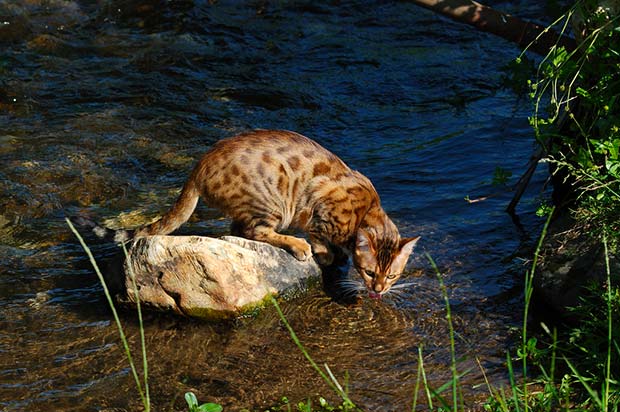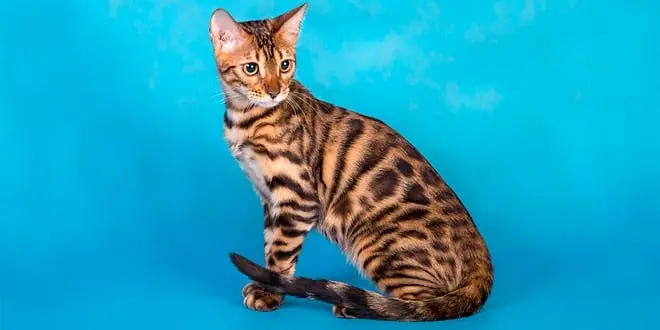[dropcap]A[/dropcap]merica loves its kitties. That’s completely evident by the fact that the U.S. ranks number one in the world for a number of cats we have at home.
Who can blame us? Cats are both enigmatic and hilarious, and their antics have dominated the Internet practically from its inception.
If you’re lucky and have a feline friend in your life, you know there’s practically no better pet.
And while there’s an enormous variety of breeds out there – kitties of all colors, shapes, and sizes – there’s one breed that’s on the rise: the beautiful Bengal.
If you have one or thought of bringing one home, there’s a lot to learn about this wonderful cat.
We’ve got all the information you need to understand Bengal cat behavior and give your new friend a great home.
Let’s break down the basics before we get to the pro tips to make you a Bengal cat behavior know-it-all.
Where Did The Bengal Come From?
The breed itself is new to the scene – starting out in the 70s and growing from there.
Even so, it’s popularity skyrocketed and now they’re among the top breeds registered with The International Cat Association.
Bengals are striking animals – their coats are marbled like little leopards and they have alert, clear eyes.
Although the Bengal cat looks like a wild animal, it’s perfectly domesticated.
These cute kitties can be loving and loyal, but as any owner knows, Bengal cat behavior can range from mysterious, to naughty, to curious in the blink of an eye.
Want to know what your pet is trying to communicate – and learn how to talk back? Keep reading!
Body Language
This is the easiest to read since you don’t even have to be close to your kitty to see it.
Cats are still animals, and there will always be an underlying trace of instincts.
They have the proverbial cat-like reflexes and you’ll know how they feel almost instantaneously.
Perhaps the most iconic is the “Halloween” stance. When a cat is scared or frightened, it tries to make itself as big as possible.
It will arch its back and stand up as tall as possible, just like all those black cat Halloween decorations.
Sometimes when your cat is scared, they might try to make themselves smaller.
They’ll crouch down and pull their legs underneath them, ready to bolt.
Sometimes your kitty will tuck their paws under, but don’t get this confused with the previous pose. A happy cat will tuck their legs up and their face will relax.
A scared cat will keep the paws close but flat on the floor, ready to run. They’ll keep their eyes open and their ears alert.
When a cat is totally relaxed, they’ll lay on their back, exposing their vulnerable stomach. Take that sign of Bengal cat behavior that they trust you.
The Eyes Have It
Cats communicate a lot with their eyes. They even kiss with them. It’s true!
When a cat slowly blinks at you, that’s a kitty kiss. That’s how they show they trust you.
If their eyes are half open, they know they can relax around you.
Wide pupils might mean your Bengal is scared, but more often than not their eyes dilate while they’re stimulated at playtime.
Constricted pupils indicated a tense or nervous kitty.
Ears Are Everything
Your cat’s ears can talk, too.
For example, if they’re up, your cat is alert and interested.
If they flatten out and lay back, your cat is scared or angry.
Look for their ears to swivel around too – this Bengal cat behavior shows that your cat is curious about every little sound.
Tattling Tail
Cats talk with their tails, just like dogs, but there are a few key differences.
The main change between a dog and Bengal cat behavior involves a wagging tail.
Dogs wag when they’re happy, but cats wag their tail when they’re mad or aggravated.
If the tail is waving side to side slowly, this might mean kitty is thinking about something. You might see this when you introduce a new toy.
A tail that’s down indicated they’re cautious, but a tail that’s all the way up means your cat is alert and content.
You’ll usually see your friend run to greet you with a tail held high.
Motor Mouth
Of all the ways cats can communicate, the meow is a bit complex.
Cats have shown in a few studies that they use meows to truly talk to their owners.
This area of Bengal cat behavior shows that our furry friends are quite intelligent.
And you will definitely hear a meow from your Bengal – along with Siamese cats, they’re one of the most vocal and talkative breeds.
Other things your cat might be trying to say:
[tie_list type=”checklist”]
- Purring – An obvious sign your cat is content
- Chattering – Sometimes, a cat will make little twittering noises, usually when watching prey outside the window. This might be the cat practicing the killing bite.
- Chirps – Has your Bengal ever given you little chirping sounds? Mama cats make this noise to get their kittens to do what they want. This is your cat saying “follow me”.
- Yowl – Cats cry out when they’re in pain, but other times it’s just to make sure they’ve really got your attention. If they get stuck in a closet or are just unhappy that you’re not paying attention to them, they’ll make sure you know it.
[/tie_list]
As you can see, this aspect of Bengal cat behavior is complex and interesting. Who knew cats had so much conversation in them?
Up Close And Personal With Your Cat
Although they have a reputation for being aloof, cats actually really love humans and want to be around them.
One of the hallmarks of Bengal cat behavior is that they love being close to their favorite person.
They have different ways of showing affection, too.
For example, sometimes a cat will head butt you. This is just their way of being affectionate but also marking you as their human.
Cats have scent glands in their foreheads that other animals can smell. By rubbing you with their personal perfume, they’re saying “this one is taken”!
Has your cat ever sniffed something of yours and suddenly made a weird face? Don’t’ be offended by this odd Bengal cat behavior.
It’s called the Flehmen response. Your Bengal is actually trying to get more information about your scent.
The cutest way cats show they love you is by kneading or “making biscuits”. Your kitty will alternately knead their paws on or near you.
When they were kittens, they would knead their mama to get the milk flowing. This is their way of regressing to their happy place and showing you they love you.
Specific Bengal Cat Behavior
Now you know many of the ways your kitty will communicate what it’s feeling, but there are a few extra tips Bengal lovers need to know.
These cats are very intelligent and there are certain aspects of Bengal cat behavior that prove just that.
One unique quirk of the breed is that they love water. Your Bengal might insist on drinking from faucets or want to accompany you in the shower.

With their high IQs, you’ll need to keep them endlessly occupied. Buy a variety of cat toys for them to play with or they’ll make their own fun.
These smart cats learn how to open doors sometimes and seem to find a way to get themselves into trouble if you don’t give them enough attention.
While cats are famous for sleeping a lot, this breed will keep you on your toes.
They’re also excellent hunters. Watch out – if you’ve got an unattended fish tank or small animal, you’ll need to keep an eye out.
Bengals will lavish you with attention and mark you as “theirs”. Get ready to be the recipient of lots of loving Bengal cat behavior.
The only problem is, if you leave the house for work, your cat will get bored and lonely.
A bored Bengal is a Bengal looking to get into trouble. Consider getting a companion for your kitty.
They’re very loving and can form a friendship with almost any other pet you introduce them to.
Bringing Home A Bengal
Now you’re ready to take home a truly wonderful pet – a Bengal cat.
With this guidebook of Bengal cat behavior, you’ve got the tools to understand the needs of this unique and playful kitty.
Since they’re so smart, if you put in the time and effort, you can even train your Bengal.
Make sure to stick with a reputable breeder, one who knows the ins and outs of this particular breed.
Bengal cat behavior doesn’t have to be a mystery anymore – your cat is trying to talk to you every day.
Now you know what they’re saying and how to reply. Your relationship is going to grow by leaps and bounds!
We would love to hear about the Bengal cat in your life; leave us a comment below and tell us what you love most about them!
[products limit=”3″ columns=”3″ orderby=”id” order=”DESC” visibility=”visible”]




